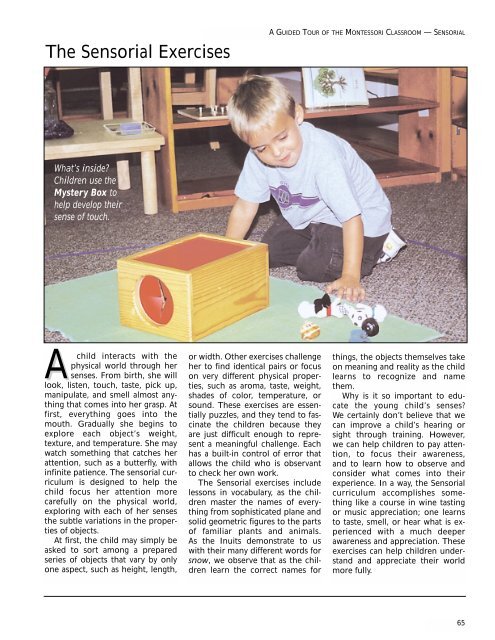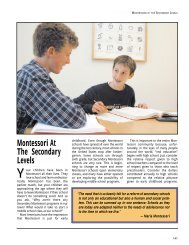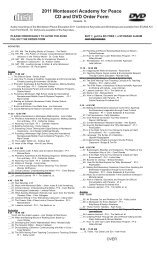Tim Seldin & Paul Epstein Ph.D. An Education for Life
Tim Seldin & Paul Epstein Ph.D. An Education for Life
Tim Seldin & Paul Epstein Ph.D. An Education for Life
Create successful ePaper yourself
Turn your PDF publications into a flip-book with our unique Google optimized e-Paper software.
The Sensorial Exercises<br />
What’s inside?<br />
Children use the<br />
Mystery Box to<br />
help develop their<br />
sense of touch.<br />
A<br />
child interacts with the<br />
physical world through her<br />
senses. From birth, she will<br />
look, listen, touch, taste, pick up,<br />
manipulate, and smell almost anything<br />
that comes into her grasp. At<br />
first, everything goes into the<br />
mouth. Gradually she begins to<br />
explore each object’s weight,<br />
texture, and temperature. She may<br />
watch something that catches her<br />
attention, such as a butterfly, with<br />
infinite patience. The sensorial curriculum<br />
is designed to help the<br />
child focus her attention more<br />
carefully on the physical world,<br />
exploring with each of her senses<br />
the subtle variations in the properties<br />
of objects.<br />
At first, the child may simply be<br />
asked to sort among a prepared<br />
series of objects that vary by only<br />
one aspect, such as height, length,<br />
or width. Other exercises challenge<br />
her to find identical pairs or focus<br />
on very different physical properties,<br />
such as aroma, taste, weight,<br />
shades of color, temperature, or<br />
sound. These exercises are essentially<br />
puzzles, and they tend to fascinate<br />
the children because they<br />
are just difficult enough to represent<br />
a meaningful challenge. Each<br />
has a built-in control of error that<br />
allows the child who is observant<br />
to check her own work.<br />
The Sensorial exercises include<br />
lessons in vocabulary, as the children<br />
master the names of everything<br />
from sophisticated plane and<br />
solid geometric figures to the parts<br />
of familiar plants and animals.<br />
As the Inuits demonstrate to us<br />
with their many different words <strong>for</strong><br />
snow, we observe that as the children<br />
learn the correct names <strong>for</strong><br />
A GUIDED TOUR OF THE MONTESSORI CLASSROOM — SENSORIAL<br />
things, the objects themselves take<br />
on meaning and reality as the child<br />
learns to recognize and name<br />
them.<br />
Why is it so important to educate<br />
the young child’s senses?<br />
We certainly don’t believe that we<br />
can improve a child’s hearing or<br />
sight through training. However,<br />
we can help children to pay attention,<br />
to focus their awareness,<br />
and to learn how to observe and<br />
consider what comes into their<br />
experience. In a way, the Sensorial<br />
curriculum accomplishes something<br />
like a course in wine tasting<br />
or music appreciation; one learns<br />
to taste, smell, or hear what is experienced<br />
with a much deeper<br />
awareness and appreciation. These<br />
exercises can help children understand<br />
and appreciate their world<br />
more fully.<br />
65




